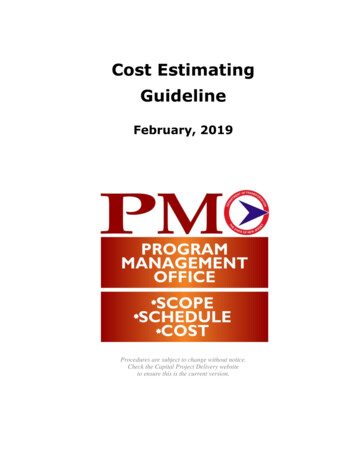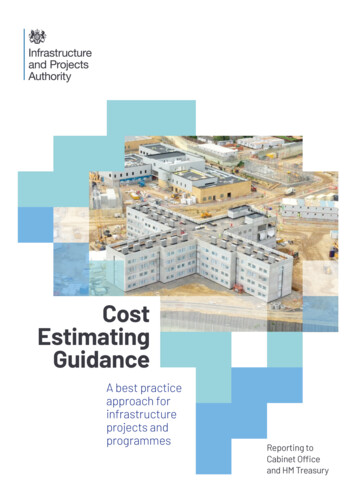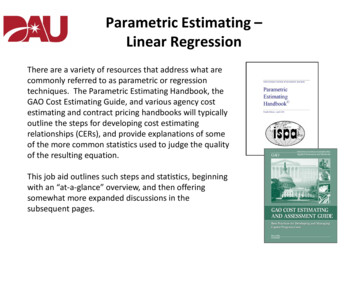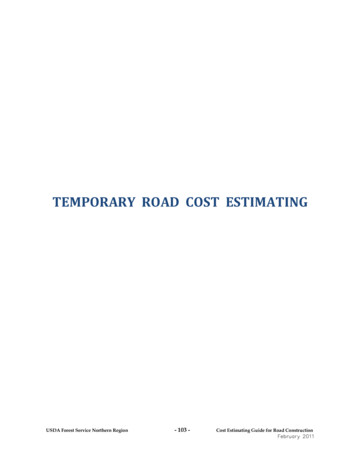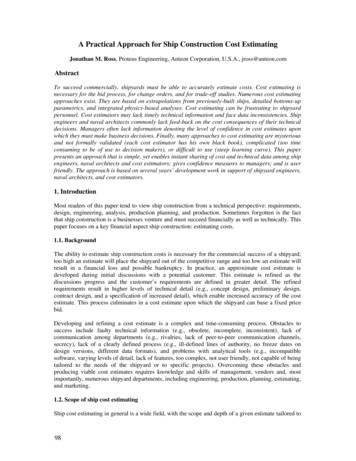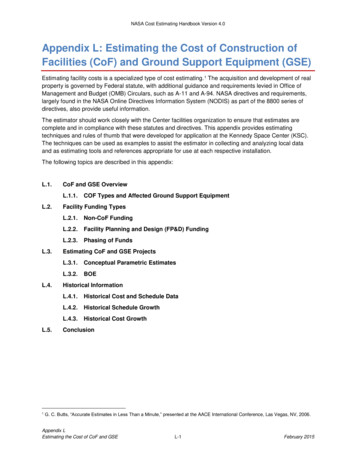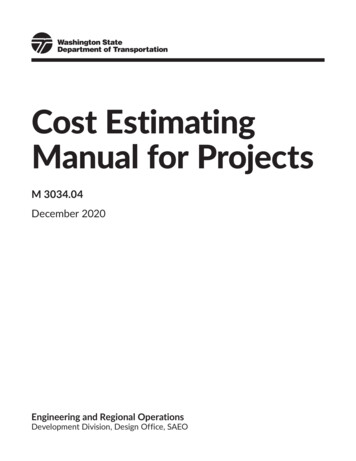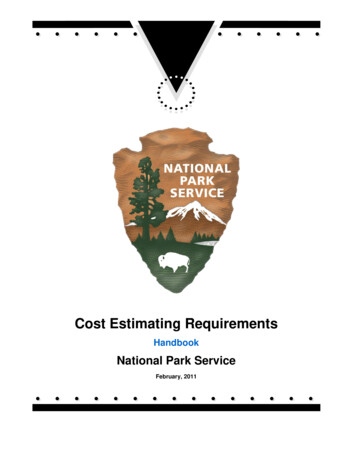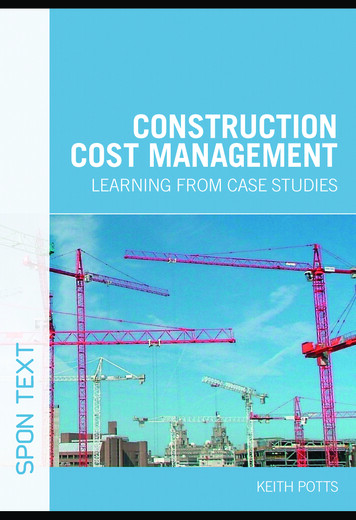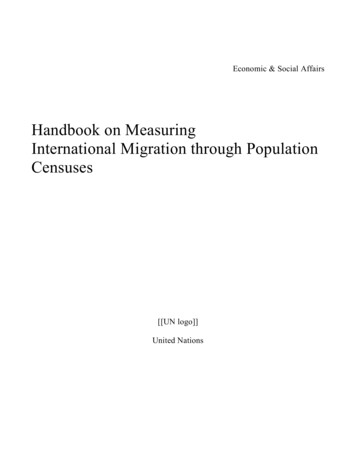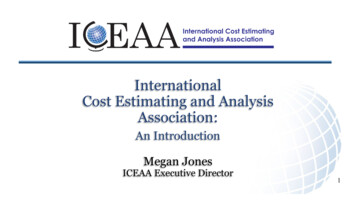
Transcription
082620InternationalCost Estimating and AnalysisAssociation:An IntroductionMegan JonesICEAA Executive Director1
HistoryIndustrial Estimating Society of San Diego1960PRICE Users Group1977International Society ofParametric Analysts1978National EstimatingSociety1966Institute for CostAnalysis1981Society ofCost Estimating & of-iceaa2
Mission StatementThe International Cost Estimating and Analysis Association is a501(c)(6) international non-profit organization dedicated toadvancing, encouraging, promoting and enhancing the professionof cost estimating and analysis, through the use of parametrics andother data-driven techniques.3
CEBoK www.iceaaonline.com/cebok4
CCEA and PCEA Certification Provide professional credentials that set thestandard for the entire cost estimating andanalysis community Offer employers and individuals a means ofdistinguishing and achieving excellence.Certification serves as a measure of an individual’smastery of the basic and intermediate knowledgein cost estimating and analysis Strengthen the individual’s and theirorganization’s ability to produce quality costestimates and analyseswww.iceaaonline.com/certification5
Certification Exam: Two PartsTake Part 1 Only for PCEATake Parts 1 & 2 for CCEA:foundation knowledgepractical applicationadvanced analysisPASS TOATTAIN2-5 years cost estimatingexperience:Awarded CCEA when 5years experience met5 or more years costestimating experienceATTAINCandidates who pass part 1 will be awardedthe PCEA designation regardless ofexperience level.To be awarded CCEA, candidates must pass both parts of the examand have 5 years of cost estimating (or related) experience.6
ICEAA's PCEA and CCEA exams can now be taken online using anycomputer with an integrated webcam and microphone.The browser-based testing software only requires an extension to deploy thevirtual AI proctor that monitors your test.www.iceaaonline.com/certification7
CCEA and PCEA CertificationJoin ICEAA (/year) 95Complete the CCEA Application* 300Join ICEAA (/year) 95Complete the PCEA application* 150Purchase & study CEBoK 235Purchase & study CEBoK 235Total Investment: 630Total Investment: 480*For applicants taking their exam online. Offline paper exams fees are subject to a 20% surcharge to cover shipping, printing, and other coordination.www.iceaaonline.com/certification8
More certification questions?www.iceaaonline.com/certificationfaq9
ICEAA Workshop ArchivesRead abstracts anddownloadpresentations frompast events:www.iceaaonline.com/archives10
Our weekly webinars are free for both members and non-membersWebinars are recorded and featured on our YouTube page for later viewingEach webinar counts as 1 hour of training towards CCEA certification renewalwww.iceaaonline.com/dls11
Our thanksWhen signing up for ICEAA membership, Active Military may choose the StudentMembership rate. Rather than the usual transcript required to qualify for this rate,send us a PDF of an email from your commanding officer, supervisor, or managerverifying your current military status.Upon approval of your completed PCEA or CCEA exam application, you will receive adiscount code to be used towards your exam fees.www.iceaaonline.com/activemilitary12
See the value of ICEAA membership for yourselfwww.iceaaonline.com/qed13
Software Cost EstimatingBody of Knowledge:past, present, and futureDr. Christian B. Smart
Introduction ICEAA has maintained a Cost Estimating Body of Knowledge (CEBoK) for along time, which serves as the foundation for its certification While there is a CEBoK module on software cost estimating, ICEAArecognizes that Software is an ever-increasing portion of total systems cost There are unique aspects of software cost estimating that merit special attention to thissubject Recognizing these facts, ICEAA decided to develop a Software CostEstimating Body of Knowledge (SCEBoK) and plans to finish the initialversion in early 2021 This briefing provides an overview of SCEBoK
2016-20182015: Established the Software Cost Estimation Training and CertificationSteering Committee with ICEAA, Nesma, and IFPUG2016: Started the Software Certification Curriculum Working Group in 2016 toidentify important topics, structure a table of contents for a softwarecost estimating curriculum2017: First appearance of the content that would become the Software CostEstimating Body of Knowledge. Seven software estimation trainingsessions featured at the ICEAA Professional Development & TrainingWorkshop In Portland, Oregon, USA2018: 14 Software CEBoK Training offerings at the 2018 ICEAA Workshop
2019ICEAA and Nesma sign a MOU committing to continue the project16 Software CEBoK training offerings at the 2019 ICEAA WorkshopThe same training is offered October 2019 at the IWSM-Mensura Conferencein Haarlem, NetherlandsICEAA begins negotiating contracts to accelerate the effort using paid v.volunteer contributionsICEAA has partnered with the U.S. Defense Acquisition University (DAU) touse their existing course materials, known as BCF-250: Software CostEstimating, as one of the foundations for SCEBoK.
2020ICEAA partners with the U.S. Defense Acquisition University (DAU) to usetheir existing software cost estimating course materials as one of thefoundations for SCEBoK (along with previously-presented softwaretraining slides and other sources)Establishes the ICEAA SCEBoK Review Group (ISRG) to collaborate and bestdevelop an industry and globally accepted productContracts a project manager to integrate the source material with ISRGfeedback to create a written, readable SCEBoK body of knowledge anda series of PowerPoint slides to use when training SCEBoK content
Expected Rollout: Early 2021 First edition will be in PowerPoint format Available for learning and instructing ICEAA is preparing a standalone specialty certification forSoftware Cost Estimating, due later in 2021 Eventual goal to offer an online narrative-format body ofknowledge
SCEBoK Target Audiences Commercial organizations Original Equipment Manufacturers (OEMs) Government organizations Consulting firms Quasi-government organizations (e.g., Federally Funded Research &Development Centers) Academic institutions
SCEBoK GoalsSCEBoK will be developed to: Ensure content is not biased towards or focused on the the US Governmentor US Department of Defense Provide users with an understanding of software estimating that willcompliment and enhance cost estimates and analyses Factually and objectively present all software sizing methods to allow usersto draw their own conclusions about the merits of any given method Provide guidance to the essential considerations in software costestimating
SCEBoK and CEBoK SCEBoK will be a specialty version of ICEAA’s Cost EstimatingBody of Knowledge (CEBoK ) Fundamental cost estimating lessons will not be repeated in SCEBoK SCEBoK will only be available as an add-on purchase to CEBoK References and links will cross between core CEBoK lessons and SCEBoK modules
Lessons 1-6 (subject to change)Lesson 1: Software Cost Estimating OverviewWhy software cost and schedule estimating is importantLesson 2: Software Development ParadigmsExplore each software development paradigm with descriptions andconsiderations
Lessons 1-6 (subject to change)Lesson 3: Preparing the software estimateStep 1: Definition & Planning (includes Scope)Step 2: Data Collection, Normalization, and AnalysisStep 3: Estimate FormulationStep 4: Risk & Uncertainty AnalysisStep 5: Documentation & Presentation
Lessons 1-6 (subject to change)Lesson 4: Tools and Techniques to Streamline the SoftwareEstimate Developing a CER Software Schedule Estimating OTS tools for developing software estimatesLesson 5: Software Maintenance Definition of software maintenance and why it is important Primary software maintenance cost drivers Methods of estimating software maintenance Software obsolescence
Lessons 1-6 (subject to change)Lesson 6: COTS & ERP Software Costing Considerations Description of COTS software and its importance Primary COTS cost drivers Best practices in COTS projects Description of ERP and its importance Primary ERP system cost drivers and estimating techniques
Why is Software Cost Estimating Important?Software is increasingly embedded (in everything)
Why Cost and Schedule GrowthOccurNumerous Reasons, BothInternal and External“The Non-Secret of Good Cost[and Schedule] Estimating:Don’t Drink the Kool-Aid”Lawrence Goeller, OSD CostAnalysis Improvement GroupSource: Christian B. Smart, Solving for Risk Management:Understanding the Critical Role of Uncertainty in Project Management12345OPTIMISMInnate bias - Planning FallacyProject managers are risk-seekingCOST, SCHEDULE,TECHNICAL MISALIGNMENTLike a three-legged stool, all need tobe consistent in order for a project tobalanceMOORE’S LAWExponential growth in technologyPaired with projects that take adecade or longer to completemeans that either there is acontinual requirements updateprocess, or the product is obsoleteon deliveryBLACK SWANSUnpredictable, rare, unprecedentedevents that have a huge impactLAKE WOBEGONProject managers and staff are notlike the children of Garrison Keillor’sfictional town – they are not allabove average
Types of software estimates (1 of 5)Software-intensiveprogram1Investment: Program/project management Systems engineering BPR/ Change management System Development System Procurement Hardware Software System level integration & test System deployment/implementationOperations & support (O&S)2 Help desk/service desk support Technology refresh/upgrade System maintenanceSoftware life cycle (example) Investment Plan (sourcing, business case, governance) Develop and/or procure Software development estimateSCEBoK Req implementationChapters 2,3,4 Software procurement estimate Integration Deployment Operations & Support (O&S) Help desk, licenses, hosting, etc. Software maintenanceSCEBoK Chapter 5 End of life1.2.Standard IT LCC WBS V5 from US Department of HomelandSecurityO&S contains continuation of many investment categories thosenew ones listed here See definitions in notesSCEBoKChapter 6
2. Elements of both Predictive and Adaptive/Agile:Incremental (1 of 2)1,2,3 Complete requirements are definedupfront and allocated to incrementsfor developmentIncremental ement 1PreliminaryDesignDetailedDesignIncrement 2PreliminaryDesignCode andTestDetailedDesign.Increment 3PreliminaryDesignCSCIIntegrationand TestCode andTestDetailedDesignIncrementsTime CSCIIntegrationand TestCode andTestCSCIIntegrationand TestSoftwaresystemTest Design, implementation, verification(and often, delivery) are allocated to aseries of increments (“softwarebuilds”), each of which is a waterfalland delivers a portion of software If increments are sequential, thencompletion of each is a “gate”through which the project must passbefore proceeding to the nextincrement; successive waterfalls1. Adapted from the DAU Glossary definition for the Incremental Approach (referenced by DoD Instruction (DoDI) 5000.2) and2. An example for the Incremental Development Paradigm is available here.3. As noted on the previous slide, we categorize the Incremental paradigm as “Adaptive/Agile” in this lesson because of the opportunity for each increment to influence the requirements, quality, etc. of thesubsequent increments. In cases where the increments are concurrent or rigidly defined, it may be more appropriate to categorize it as a Predictive paradigm
Software is an ever -increasing portion of total systems cost There are unique aspects of software cost estimating that merit special attention to this subject Recognizing these facts, ICEAA decided to develop a Software Cost Estimating Body of Knowledge (SCEBoK) and plans to finish the initial version in early 2021
